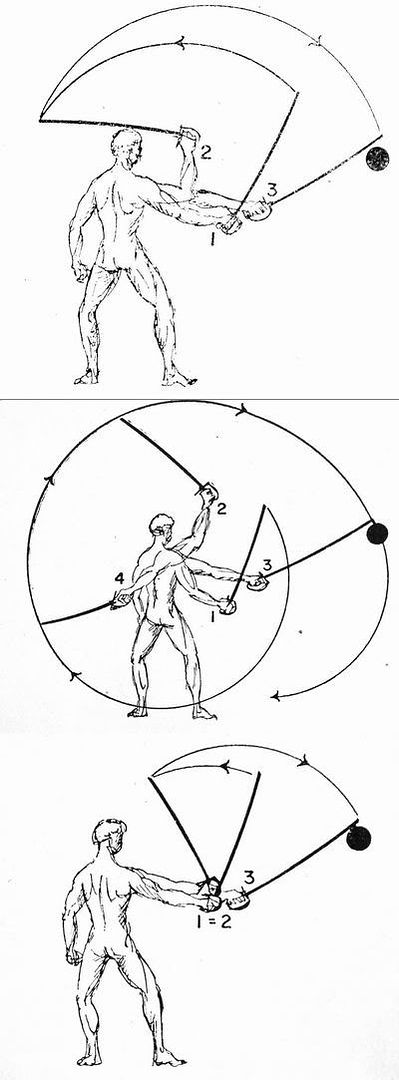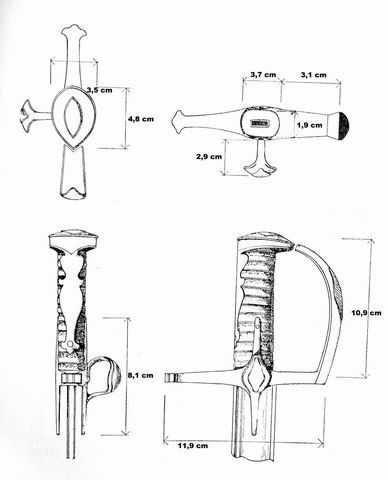
 |
|
|
#1 |
|
Member
Join Date: Dec 2004
Location: Poland, Krakow
Posts: 418
|
Dear forum Members!
In the one of the previous threads, our Transylvanian friend – Radu, asked me about my avatar, which is a picture of Polish hussar sabre (polska szabla husarska - in Polish). I promised him to send some pictures of this beautiful weapon, but I decided to do that by the post for a few reasons: 1. I’m sure that some basic information about this excellent 17th century weapon might be interesting for other forum members; 2. There is completely lack of Polish weapons on this forum, and I decided to make a little break with this exception. I would like to write a short history of sabre in Poland – very short indeed, because I would like to concentrate around this specific sabres. The only obstacle is my imperfect English, so please forgive me any misunderstandings and errors Radu – you requested, you got it  Sabre in Poland appeared in early medieval period. It wasn’t very popular weapon, especially after Tatar’s invasion in 13th century, where sabre was in use, but in enemy’s hands. This event caused that sabre disappeared for some time, and it was used only by peasants in case. This situation began to change in 15th century, but for real, sabre was accepted in 16th century through strong Hungarian influences. To be exact armament in Poland was the mixture of many influences from west, east, south, but it just from Hungary, thanks to great king Stephanus Batori from Siedmogrod (Transylviania  ) sabre became very popular in Poland. The sabre which was in use in those times, with crossed guard at the hilt, with widely ended blade (with so called mlotek) was the first really popular curved-blade weapon in Poland. It is called Hungarian- or Polish-Hungarian type sabre, and was in use for a long time, up to the end of 17th century. But of course at the end of this century it was decidedly less popular especially because sabres were still improving. ) sabre became very popular in Poland. The sabre which was in use in those times, with crossed guard at the hilt, with widely ended blade (with so called mlotek) was the first really popular curved-blade weapon in Poland. It is called Hungarian- or Polish-Hungarian type sabre, and was in use for a long time, up to the end of 17th century. But of course at the end of this century it was decidedly less popular especially because sabres were still improving.The sabre quickly became the most important weapon in Poland, esteemed even as a National weapon. The source of this thinking was not only this was great, effective weapon. The sabre became the indication of nobility, just like a sword of knighthood. It’s nothing uncommon, becouse it occured in many other countries, where some sort of weapons belongs only to concrete social group. Here in Poland, the sabre became also an object of some sort of religious, political and courage manifestation – because of inscriptions engraved, etched, gilded, etc, on the blade (for example sabre batorowka – with bust of king Batori, sabre zygmuntowka – with bust of king Sigismund III Wasa, take a look at inscription of this sabre from my avatar, etc etc). The importance of the sabre in Poland was also in naïve belief in origin of Polish noblemen in antique people of Sarmatians, from the east (and the sabre was an eastern weapon, so it was easy to connect this two things for our ancestors). The sabre was so strong associated with noblemen that even for children were made small, cute sabres. There are many evidences of union: nobleman-sabre. One of the most expressive is descripted by one of Polish memoirist, Kajetan Kozmian (half of the 18th century), when he as a young boy, took a trip to the market in the new, beautiful, fancy work kontusz (Polish national costume) with gilded buttons. Unfortunately he forgot sabre with him. He met a few drunken noblemen on his way, and they seeing young boy in such a costume without a sabre, stated he must be a peasant, who is illegaly wearing noble’s kontusz – so let get him, we will give him a lesson! They were so randy, they were chasing poor guy to his house and even to his attic where he decided to hide, and where his domestic service scarcely rescued him. So the nobleman without a sabre wasn’t a nobleman! Imrovments made during 17th century where concentrated, among other things, around hilts which were gradualy modified. Before close-hilted sabre apeared, there were cross-hilted Polish-Hungarian sabres with chain running from the guard to pommel – it was minimal protection for fingers. Next one had a hilt with crossed-guard, which curved at an right angle (90 degrees, looked like a letter “L”). After this, close-hilted, the real so-called hussar sabre was created – when? it’s hard to say, probably at the beginning of the 4th quarter of the 17th century – but some researchers date this moment at a half of this century. The “hussar sabre” is only a common name. It doesn’t mean it was regulation sabre of this heavy Polish cavalry (do not mix up this hussars with light hussars from the 18th century, apearing in almost every army of the world, known also from the “Vivat hussar” blades!). It was just a noblemen’s sabre. By the way, there were many others names for them. One of the most popular was “Husar pallash” – nowadays pallash is qualification only for the weapon with straight blade! It was also called “czarna szabla” – “black sabre” because of the black shagreen at the sheath and hilt. The sabre from my avatar (which is property of National Museum in beautiful city of Krakow) is classical hussar sabre, from the best period. Even more. The sabre constructed like this one, is unanimously proclaimed by army lovers and experts, the best edged weapon in Europe of this time. And it’s for sure remarkable creation of Polish craftmanship ever. The most important for edged weapons are of course blades – there were plenty species of them, in Poland too. But in sabres like this, it is a hilt, what determine and specify the way of fighting. There are two important improvements in hussar sabres hilts: 1. Thumbring (paluch), adopted through western influences, present earlier in some Polish-Hungarian type sabres 2. Knuckle-guard which is prolongation of the hilt, curved at an angle of 100-105 degrees. Because of its features (especially thumbring!) specify cuts are possible with this sabre: - depends on main rotation axis: cut from the shoulder, from the elbow, from the wrist - depends on position: 1. swinging cut (blade is stopped during the hit) 2. circular cut (the blade is in its maximum speed during the hit) 3. direct or rebounding cut (short move and fast return after the hit to parry opponent’s move)  [Drawings from Andrzej Zablocki’s article Funkcjonalno-konstrukcyjna charakterystyka rekojesci dwoch typow polskich szabel bojowych z wieku XVII (Construction and function of two Polish war sabre hilts of the 17th century) [in] Studia do dziejow dawnego uzbrojenia i ubioru wojskowego, T. V, Krakow 1971] The thumbring was most important piece for rebounding cuts, because during the cut, the pressure exerted by the thumb upon the thumbring enabled quick and efficacious direct cut, with fast return (just like in Japanese fencing, but with one hand). Another innovation was the knuckle-guard not connected to the pommel! It was very important because it was not only protecting our hand, but enables elasticity of the handle during great pressure, when upper end loose acted like a spring when struck. The construction of the blade, its weight, length and formation was important for purposes of attack. It was different with Polish-Hungarian type sabre with wide and heavy mlotek, different with lighter blade of hussar sabre. The first were designed mainly for crushing blows, further mainly for fast rebounding blows. This specific sabre from avatar was made by Lviv’s Ormians, acting on the turn of the 17th and 18th century, gathered around so-called “Lviv Manufacture” (nowadays west Ukraine). As you probably noticed, the floral decoration is very similar to Persian articles of this time. It’s not accidental. Persian products were very popular and fashionable in Poland, but very expensive because of distance between two countries, and many other events like Polish war with Ottoman Empire, when Polish trade with Persians was limited. That’s why Ormian’s products were such popular – very similar to Persian work, with approximate quality, solved “stylish” problem of our noblemen. The hilt of this sabre is made of gilded and engraved silver, with applications of silver plates decorated with niello, which is used as a background for floral design. To be honest, I would judge this niello work as “good” but definitely not excellent, because Ormians were making better works in niello, as you can see (for example) on buzdigan-mace from my museum (maybe someday I’ll post it). The hilt is of course cross-shaped, with flat end on one side (another typical element) and prolonged to the knuckle-guard on the other, plus crosswise element (I’m sorry, don’t know English term, Polish “wasy”) used to hold a sheath. The pommel is prolonged to so-called “warkocz”, which covers the back of the grip. The tang is made of wood, covered with black leather – shagreen, wrapped around with gilded chain (silver band also was in use). Blade is with two broad fullers, and with double edged point. There is engraved inscription on the one side of the blade: “IEZVS MARIA IOZEF / DEVS SPES MEA” (Jesus Mary Joseph / God is my hope) and a signs made of V letters – with unknown purpose like many others made on sabres in 17th century (oOoOoO, IPZD etc.). Notice the fuller at the back of the blade. Sheath is made of wood, covered with black shagreen, with beautiful gilded, engraved silver fittings with niello applications. Weight of the sabre is 0,948 kg, of the sheath 0,492 kg. Measurements:   The life of hussar sabres was unfortunately short, in spite it was perfect weapon. They were modified in 18th century in many ways, through western influences. It was probably because the Polish armament at the end of the 17th century couldn’t inspire western world (just like at the beginning and at the middle of this century) during the local military system was in decay. Western influences increased after Augustus II, Elector of Saxony became a king of Poland in 1697. The Polish army remind itself this weapon after the II World War. In 1976 a parade sabre was made, which refered to the hussar sabres in shape and proportions Radu, I’m sorry you had to wait for the photos so long, but I made them in very bad light, and they needed a little betterment  . Because of forum pixels limitation, you can find below links to hi-res pictures, which I hope will reward your expectation . Because of forum pixels limitation, you can find below links to hi-res pictures, which I hope will reward your expectationBest wishes Michal links to hi-res pictures  overall view: http://img.photobucket.com/albums/v4...001husaria.jpg http://img.photobucket.com/albums/v4...002husaria.jpg hilt: http://img.photobucket.com/albums/v447/wolviex/003a.jpg http://img.photobucket.com/albums/v447/wolviex/007a.jpg http://img.photobucket.com/albums/v447/wolviex/004a.jpg http://img.photobucket.com/albums/v447/wolviex/008a.jpg http://img.photobucket.com/albums/v447/wolviex/009a.jpg http://img.photobucket.com/albums/v447/wolviex/010a.jpg blade: http://img.photobucket.com/albums/v447/wolviex/011a.jpg http://img.photobucket.com/albums/v447/wolviex/011b.jpg http://img.photobucket.com/albums/v447/wolviex/012b.jpg http://img.photobucket.com/albums/v447/wolviex/013a.jpg sheath http://img.photobucket.com/albums/v447/wolviex/014a.jpg http://img.photobucket.com/albums/v447/wolviex/015b.jpg http://img.photobucket.com/albums/v447/wolviex/016a.jpg |
|
|

|
| Thread Tools | Search this Thread |
| Display Modes | |
|
|